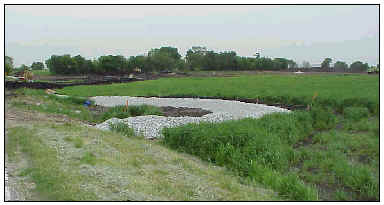
|

|
To Print Use The pdf File
ILLINOIS URBAN
MANUAL
PRACTICE STANDARD
CULVERT
INLET PROTECTION
(no.)
CODE 808
 (Source: Kane-Dupage Soil and Water Conservation District) |
DEFINITION
A temporary sediment filter located at the inlet to storm sewer culverts.
PURPOSE
The purpose of this practice is to prevent sediment from entering, accumulating in and being transferred by a culvert and associated drainage system prior to permanent stabilization of a disturbed project area.
CONDITIONS WHERE PRACTICE APPLIES
This practice applies where a culvert and associated drainage system are to be made operational prior to the stabilization of the disturbed drainage area.
CRITERIA
All culvert inlet protection shall be constructed in a manner that will facilitate cleanout and disposal of trapped sediment and minimizes interference with construction activities.
All culvert inlet protection shall be constructed in such a manner that any resultant ponding of stormwater will not cause inconvenience or damage to adjacent areas or structures.
Silt Fence Culvert Inlet Protection
This type of culvert inlet protection has an expected maximum usable life of 3 months.
The maximum area draining to this practice shall be 1 acre.
All criteria included in practice standard SILT FENCE 920 shall apply except the maximum spacing between the posts shall be 3 feet and tops of posts shall be cross-braced.
The placement of the silt fence shall be a minimum of 6 feet from the culvert in the direction of incoming flow, creating a "horseshoe" shape.
If the drainage area exceeds 1 acre, or flow and/or velocity of the flow to the culvert inlet protection is excessive and may breach the structure, use the Stone Culvert Inlet Protection criteria.
Stone Culvert Inlet Protection
Stone culvert inlet protection has a maximum expected useful life of 18 months.
The maximum area draining to this practice shall be 3 acres. For drainage areas larger than 3 acres install a temporary sediment trap meeting the requirements of practice standard TEMPORARY SEDIMENT TRAP 960.
The stone culvert inlet protection is a small stone berm in a horseshoe shape around the culvert inlet. The upstream half of the stone berm shall consist of coarse aggregate meeting IDOT CA-1, CA-2, CA-3 or CA-4 gradation and the downstream half of the stone berm shall consist of riprap meeting IDOT RR-3 or RR-4 gradation. In addition, any riprap that is used for permanent protection on the culvert inlet embankment shall meet IDOT Quality Designation A.
The downstream toe of the stone berm shall be no closer than 24 inches from the culvert opening in order to provide an acceptable emergency outlet for flows from larger storm events.
Maximum height of the stone berm shall be 3 feet.
Side slopes of the stone berm section shall not exceed 2:1 horizontal to vertical.
The stone berm shall be tied into the culvert embankment a minimum of 1 foot above the design elevation of the stone berm.
CONSIDERATIONS
When construction on a project reaches a stage where culverts and other storm sewer appurtenances are installed and many areas are brought to a desired grade, the erosion control measures used in the early stages normally need to be modified or may need to be removed altogether. At that time, there is a need to provide protection at the points where runoff will leave the area via culverts and drop or curb inlets.
Similar to drop and curb inlets, culverts that are made operational prior to the stabilization of the associated drainage areas can convey large amounts of sediment to drainageways or water bodies. In cases of extreme sediment loading, the pipe or pipe system itself may clog or lose a major portion of its capacity. To avoid these problems it is necessary to prevent sediment from entering the culvert by using one of the culvert inlet protection types identified in this standard.
Filter fabric may be used under the stone to provide a stable foundation and to facilitate removal of the stone.
Other protection strategies should be used if this practice has hydraulic impacts off of the subject property.
PLANS AND SPECIFICATIONS
Plans and specifications for installing culvert inlet protection shall be in keeping with this standard and shall describe the requirements for applying the practice to achieve its intended purpose. As a minimum include the following:
All plans shall include installation, inspection, and maintenance schedules with the responsible party identified.
Standard drawings IL-508SF CULVERT INLET PROTECTION - SILT FENCE or IL-508ST CULVERT INLET PROTECTION - STONE may be used as the plan sheet(s).
OPERATION AND MAINTENANCE
The structure shall be inspected after every runoff producing rain and repairs made as needed.
If aggregate is used, it shall be replaced or cleaned when inspection reveals that clogged voids are causing ponding problems.
Sediment shall be removed and the impoundment restored to its original dimensions when sediment has accumulated to one-half the height of the fence or stone berm.
Removed sediment shall be deposited in a suitable area and in such a manner that it will not erode and cause sedimentation problems.
Temporary structures shall be removed when they have served their useful purpose, but not before the upslope area has been permanently stabilized.
REFERENCES
Illinois Department of Transportation, 1997. Standard Specifications for Road and Bridge Construction. IL
NRCS IL January 1999